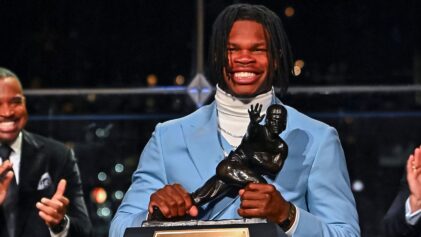The story of Ernie Davis is one of triumph and tragedy. Born in New Salem, Pennsylvania, Davis was raised by his maternal grandparents until he was 12 years old before moving to Elmira, New York to live with his mother and stepfather. He would excel at team sports throughout grade school and attended Elmira Free Academy for secondary school education, where he earned All-American accolades twice.
At the behest of Syracuse University alumnus and all-time football great Jim Brown, Davis decided to suit up for the Orange for his collegiate career. He wore number 44, like Brown before him, starting a tradition among Syracuse running backs that lasted until the number was retired in 1998.
As a sophomore, Davis dominated the competition and helped the Cuse win the national championship, defeating the Texas Longhorns in the 1960 Cotton Bowl to go 11-0. Davis earned the title game’s Most Valuable Player award. That game was infamously filled with racial tension. At the time, many big time football schools in the south were resistant to recruiting black players.
A Tribute to Ernie Davis – Syracuse Football
With this documentary, Syracuse University celebrates the 50th Anniversary of Ernie Davis, Class of 1962, becoming the first African-American to win the Heisman Trophy. Watch more Syracuse Orange videos: https://www.youtube.com/suathletics Subscribe to videos from the Syracuse Orange: https://www.youtube.com/subscription_center?add_user=suathletics Follow us on Twitter: https://twitter.com/Cuse Like us on Facebook: https://www.facebook.com/SyracuseOrange Follow us on Instagram: http://instagram.com/syracuseathletics Visit our Homepage: http://www.cuse.com Syracuse University is a member of the Atlantic Coast Conference, a Division I NCAA intercollegiate athletic conference.
A 1960 article in Life magazine summarized the atmosphere.
At first in the game, the Syracuse players outdid themselves in showing what good sports they were, helping blocked Texans off the ground and slapping their rumps for friendly good measure. But this was short-lived. “Texas was really dirty,” said one Syracuse player afterward. “We’ve never met a bunch like that before.”
What enraged them most was that much of Texas’ dirty play seemed to be directed toward Syracuse’s Negro players. Once when he was plowing through the line, said Negro fullback Art Baker, “one of them spit right in my face.”
John Brown, a Negro lineman, played nose to nose against 235-pound Texas tackle Larry Stephens. To goad him off balance, Brown claimed, Stephens kept calling him “a big black dirty nigger.” Finally, Brown warned him not to call him that again. When Stephens did, Brown swung.
In his junior year, Davis would average 7.8 yards per carry but the Orange failed to earn a bowl appearance with a 7-2 record. During his senior year of 1961, he led Syracuse to a 8-3 record and a win over the Miami Hurricanes in the Liberty Bowl.
Davis would become the first black player to win the Heisman Trophy following his senior season. It was such a significant accolade that President John F. Kennedy, a big fan, invited him to the White House and sent him a congratulatory telegram.
undefined
undefined
Davis would be selected with the number one pick in the 1962 draft by the Washington Redskins and was traded to the Cleveland Browns. Redskins owner George Preston Marshall, a segregationist who resisted integrating his team and admitted to doing so to assuage concerns of a largely southern white fan base, had to be threatened into even considering it.
The only reason Marshall drafted Davis in the first place was due to an ultimatum from Interior Secretary Stewart Udall telling the owner that he risked revocation of the Redskins 30-year lease at D.C. Stadium if he didnt sign a black player by the start of the 1962 season. Even with that warning, he wouldnt pull the trigger. Indeed, racism dies a gargling, defiant, cursing and spitting death. Always has.
However, he left the decision to GM and head coach Bill McPeak, who picked Davis. The Syracuse star would refuse to play for the Redskins and demanded the trade that landed him in Cleveland. It was orchestrated by legendary coach Paul Brown, without the consent or knowledge of owner Art Modell. His three-year, $200,000 deal was the most lucrative rookie contract at the time.
Banks was eventually diagnosed with acute monocytic leukemia prior to the College All-Star Game against the Green Bay Packers after awaking with swelling in his neck.
A power struggle between Coach Brown and Modell would become even worse when Modell hired doctors that eventually diagnosed Davis as being well enough to play, but the coach still wouldnt let him play despite his ailment being in remission.
This was the beginning of the end of relationship between Paul Brown and the Cleveland Browns. Ernie Davis died on May 18, 1963 at Cleveland Lakeside Hospital. He was 23 years old. But his legacy can be recalled anytime a black collegiate player takes home the Heisman. In those moments, Ernie Davis lives on forever.
The Express Official Trailer #1 – Dennis Quaid Movie (2008) HD
Subscribe to TRAILERS: http://bit.ly/sxaw6h Subscribe to COMING SOON: http://bit.ly/H2vZUn Subscribe to CLASSIC TRAILERS: http://bit.ly/1u43jDe Like us on FACEBOOK: http://goo.gl/dHs73 Follow us on TWITTER: http://bit.ly/1ghOWmt The Express Trailer – Directed by Gary Fleder and starring Rob Brown, Dennis Quaid, Darrin Dewitt Henson, Omar Benson Miller, Nelsan Ellis.
Davis’ tragic life would be made into the Gary Fleder biopic The Express, starring Rob Brown and Dennis Quaid.
As college football is set to honor another Heisman Trophy winner this weekend, we pay our respects to the late, great Ernie Davis, the trailblazer. It was once said that if Jim Brown didn’t win the Heisman, no Black college football player ever would. Davis, with his remarkable senior year, made sure that would never be the case.



